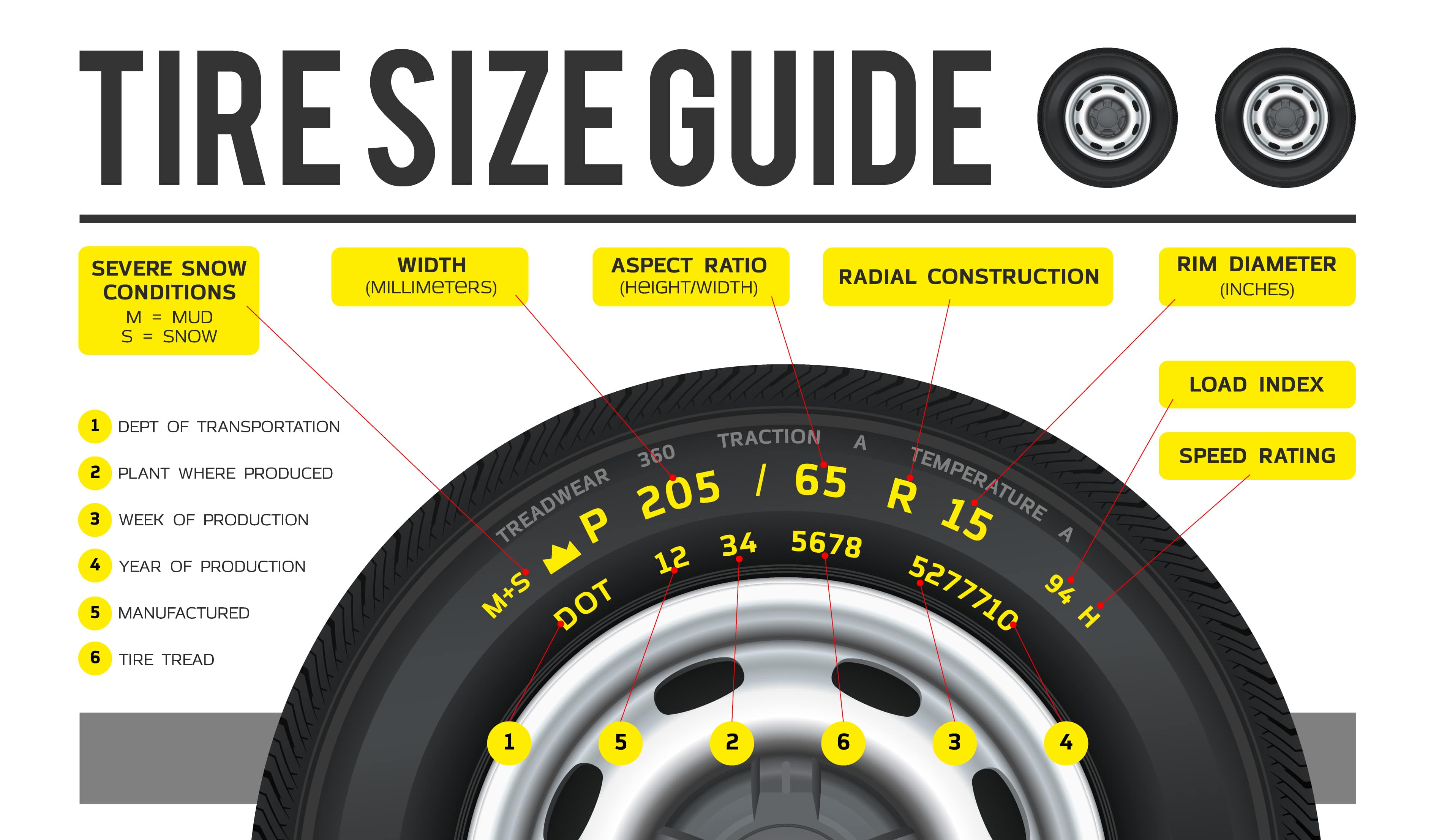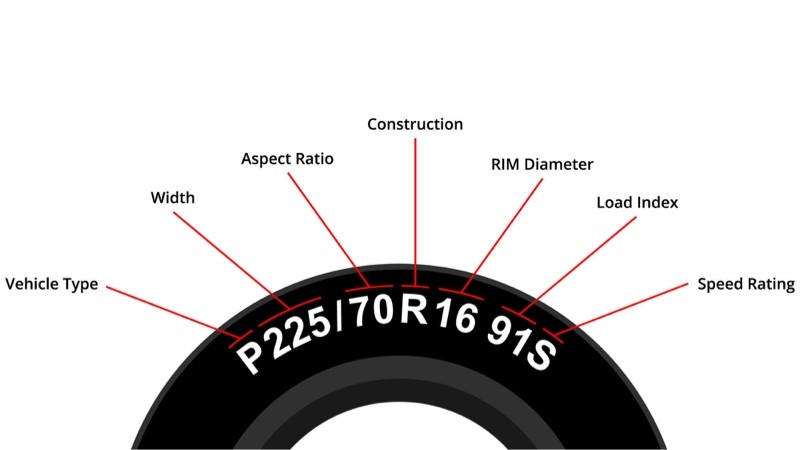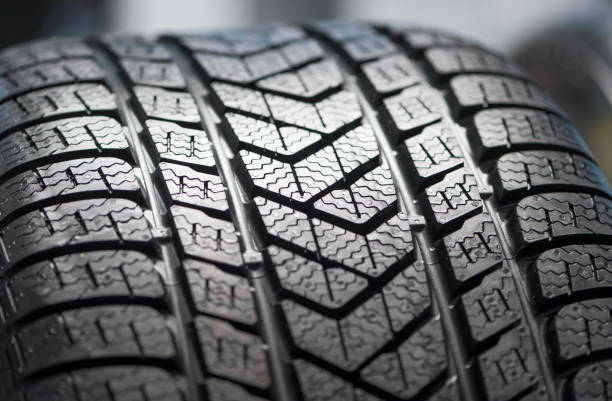Tire sizes indicate the dimensions of a tire, including width, aspect ratio, and diameter. These measurements ensure proper fit and performance.
Understanding tire sizes is crucial for vehicle safety and performance. The size is usually printed on the tire sidewall. For example, “P225/50R17” denotes a tire’s width in millimeters, aspect ratio, and diameter in inches. Proper tire size affects handling, fuel efficiency, and overall ride comfort.
Mismatched tires can lead to uneven wear and reduced vehicle performance. Knowing how to read tire sizes helps you choose the right tires for your vehicle. This knowledge ensures you maintain optimal driving conditions and prolong tire lifespan. Always consult your vehicle’s manual or a tire professional for accurate tire sizing.
Deciphering Tire Size Notation
Understanding tire sizes can be confusing. Those numbers and letters on the tire sidewall hold important information. They tell you the tire’s width, height, and type. This guide will help you decode this notation easily.
The Meaning Behind Numbers And Letters
Each tire has a unique code. This code includes numbers and letters. These symbols represent specific details about the tire.
- Width: The first three numbers show the tire’s width in millimeters.
- Aspect Ratio: The next two numbers after the slash indicate the height-to-width ratio.
- Construction Type: The letter following the ratio shows the tire’s construction.
- Diameter: The last two numbers represent the wheel diameter in inches.
An Example Breakdown
Let’s break down a common tire size: P215/65R15.
| Component | Value | Meaning |
|---|---|---|
| P | Passenger | Type of vehicle |
| 215 | Width | 215 mm wide |
| 65 | Aspect Ratio | 65% of the width |
| R | Radial | Radial construction |
| 15 | Diameter | 15 inches |
In this example, the tire is for a passenger vehicle. The width is 215 mm. The height is 65% of the width. The tire has radial construction. The diameter of the wheel is 15 inches.

Types Of Tire Sizing Systems
Understanding tire sizes can be confusing. Tire sizes come in different systems. Knowing these systems helps you pick the right tire. Let’s explore the main types of tire sizing systems.
Metric Vs. Inch Sizing
The two common tire sizing systems are Metric and Inch. Metric sizing is more popular. It uses numbers and letters to describe tire dimensions.
| Metric Sizing | Example |
|---|---|
| Width in millimeters | 205 |
| Aspect ratio | 55 |
| Rim diameter in inches | 16 |
For example, a tire marked 205/55R16 means:
- 205 mm wide
- 55% aspect ratio
- 16-inch rim
Inch sizing is simpler. It uses only inches to describe tire size. For example, a tire marked 31×10.50R15 means:
- 31 inches tall
- 10.5 inches wide
- 15-inch rim
Understanding Load Index
The load index is a number that tells the tire’s load capacity. This number is usually found on the tire’s sidewall. It is important to choose a tire with the right load index for your vehicle.
| Load Index | Maximum Load (lbs) |
|---|---|
| 75 | 853 |
| 80 | 992 |
| 85 | 1135 |
For example, a tire with a load index of 80 can carry 992 lbs. Always check the load index before buying new tires.
Interpreting Tire Width And Aspect Ratio
Understanding tire sizes is crucial for selecting the right tires for your vehicle. Two key elements in tire sizes are tire width and aspect ratio. Let’s break down what these terms mean and how they affect your driving experience.
How Width Affects Performance
The tire width is the measurement of the tire’s width in millimeters. It’s the first number in the tire size code. For example, in a tire size marked as 205/55R16, the width is 205 millimeters.
- Wider tires offer better grip and stability.
- Narrower tires provide less rolling resistance, improving fuel efficiency.
Wider tires are perfect for performance cars. They provide better traction. Narrower tires are better for everyday driving. They offer a smoother ride.
Aspect Ratio And Ride Quality
The aspect ratio is the height of the tire’s sidewall. It’s expressed as a percentage of the tire’s width. In the size 205/55R16, the aspect ratio is 55. This means the height is 55% of the tire’s width.
| Aspect Ratio | Ride Quality |
|---|---|
| Low Aspect Ratio | Better handling, stiffer ride |
| High Aspect Ratio | Smoother ride, less responsive handling |
A lower aspect ratio means a shorter sidewall. This improves handling but makes the ride stiffer. A higher aspect ratio means a taller sidewall. This provides a smoother ride but less responsive handling.

The Role Of Diameter In Tire Sizes
Understanding tire sizes is crucial for vehicle performance. One important aspect is the diameter of the tire. The diameter affects various aspects of driving, including speed, handling, and compatibility with the vehicle.
Matching Diameter To Vehicle Type
The diameter of a tire should match the vehicle’s specifications. Different vehicles require different tire diameters. Here are some examples:
| Vehicle Type | Typical Tire Diameter (inches) |
|---|---|
| Compact Car | 13-15 |
| Sedan | 16-18 |
| SUV | 18-22 |
| Truck | 20-24 |
Choosing the correct diameter ensures the tire fits well. This prevents issues with the suspension and wheel well.
Influence On Speed And Handling
Tire diameter has a direct impact on speed and handling. A larger diameter increases the rolling circumference. This means the vehicle covers more ground with each rotation. This can affect speedometer accuracy.
Smaller diameters offer better handling. They provide quicker response to steering inputs. Larger diameters can offer better stability at high speeds. Each diameter type has its specific benefits and drawbacks.
Choosing the right tire diameter involves balancing speed and handling needs. Proper diameter selection increases vehicle performance and safety.
Speed Ratings And Tire Safety
Understanding tire sizes can be complex, especially when considering the importance of speed ratings and tire safety. Speed ratings indicate the maximum speed a tire can handle safely. This ensures your vehicle performs optimally, especially during high-speed drives. Choosing the right speed rating is crucial for both safety and performance.
Speed Rating Chart
| Speed Rating | Max Speed (mph) |
|---|---|
| N | 87 |
| P | 93 |
| Q | 99 |
| R | 106 |
| S | 112 |
| T | 118 |
| U | 124 |
| H | 130 |
| V | 149 |
| Z | 149+ |
| W | 168 |
| Y | 186 |
Selecting The Right Speed Rating For Your Car
To select the right speed rating, first check your vehicle’s manual. This will provide the recommended tire specifications.
Consider how you use your car. Do you often drive at high speeds? Choose a tire with a higher speed rating.
Ensure that the tires you select match all four wheels. Mismatched speed ratings can affect the car’s handling and safety.
Here are some quick tips:
- Daily Commuting: S or T speed ratings are sufficient.
- Highway Driving: Consider H or V ratings for better performance.
- Sports Cars: Opt for W, Y, or Z ratings for maximum safety.
Always prioritize safety over speed. Properly rated tires ensure a smooth, safe ride.

Frequently Asked Questions
What Do The Three Numbers On Tire Size Mean?
The three numbers on a tire size indicate width, aspect ratio, and diameter. For example, in 205/55R16, 205 is the width in millimeters, 55 is the aspect ratio (height to width ratio), and 16 is the diameter in inches.
Which Tire Is Taller 50 Or 60?
A 60 series tire is taller than a 50 series tire. The number indicates the tire’s aspect ratio.
Can I Use 275 Tires Instead Of 265?
Yes, you can use 275 tires instead of 265. Ensure they fit your vehicle’s wheels and maintain proper clearance. Always check with a professional before making changes.
Can I Use 215 Tires Instead Of 225?
Yes, you can use 215 tires instead of 225, but it may affect handling and speedometer accuracy. Always consult your vehicle’s manual.
What Do Tire Sizes Mean?
Tire sizes indicate the tire’s width, aspect ratio, and diameter. These measurements ensure the tire fits your vehicle properly.
Conclusion
Understanding tire sizes is crucial for vehicle safety and performance. Properly chosen tires improve driving experience and fuel efficiency. Always consult your vehicle’s manual or a tire professional. This ensures you select the right tires for your needs. Stay informed and drive with confidence.





















